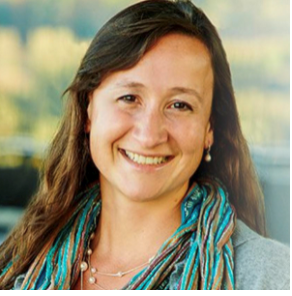Training Better Science Writers
A pilot collaboration between neuroscience and the Writing in the Disciplines program aims to enhance writing instruction
A pilot collaboration between neuroscience and the Writing in the Disciplines program aims to enhance writing instruction

Mario Muscedere has long been impressed with the writing abilities of his neuroscience undergraduates. As many as 15 percent of majors complete a written honors project, for instance, and Muscedere—who is the director of the undergraduate program in neuroscience, as well as a senior lecturer in biology—says they are often “exceptional.” So, when Muscedere was approached by David Shawn, associate director for the Writing in the Disciplines program, with the opportunity to spend an entire academic year looking for ways to improve writing instruction and opportunities for the nearly 400 undergraduates in his program, he didn’t think twice about taking it.
“Why wouldn’t we lean into this a little bit more and just shore up the strength even further?” says Muscedere. “Our thinking was, we already have some strength here—let’s build on it.”

In a first-of-its-kind collaboration, Muscedere and three of his colleagues—lecturers Kristen Bushell, Kyle Gobrogge, and John Tullai—partnered with the Writing Program’s Jessica Kent to create the college’s first academic writing plan. Together, Shawn says they “reviewed, reconsidered, and revised” writing instruction and assignments in undergraduate courses with the goal of improving the caliber of communicators graduating with neuroscience degrees. Developing program-specific writing plans is part of BU’s Writing in the Disciplines (WID) approach, and was made possible with a $75,000 gift from Jennifer Simpson (’00). The program’s writing plan sets out curricular and pedagogical goals to standardize practices, develop an archive of resources, and expand opportunities for students to write in upper-level courses, including producing pieces of scientific journalism.
Big Gift, Big Plans
Discipline-specific writing support, as an approach to academic writing, has been around for nearly a half-century, Shawn says. Today, hundreds of universities around the world use it. While BU has long supported writing across its colleges and departments, the WID initiative—which is run out of the CAS Writing Program—began in 2017 with the implementation of new general education writing requirements for undergraduates. Simpson’s gift sustains this work, which includes two additional WID programs: the peer-to-peer Tutoring Writing in the Disciplines (TWID) program, as well as training in writing for faculty. In a 2012 Writing Program survey of CAS faculty, three-quarters had expressed a desire for department-based writing tutors to support student writing in their disciplines. Since the implementation of TWID in 2018, Shawn says they have held more than 1,000 tutoring appointments with undergraduates in the neuroscience, sociology, and history of art and architecture departments. The TWID program recently expanded to include classical studies, history, philosophy, and world languages and literature.
“The undergraduates who have served as department-based writing tutors have done amazing work in advocating for fellow students and supporting them as writers,” Shawn says.
Neuroscience faculty have also received support through writing workshops, and plans are underway to expand professional development opportunities to other departments.
And the writing plan process that kicked off in the 2021–2022 academic year, Shawn says, “can enable departments and programs to think creatively about their students’ experience of writing within their discipline and can lead to innovations and creative approaches to teaching and using writing.”
Better Writers, Better Scientists
Whether someone is explaining the contours of a research project in a grant proposal, translating the results of a study for a general-audience publication, or applying to graduate school, neuroscientists—like scientists of every stripe—need to be able to communicate complicated concepts in clear and interesting ways. But many people working in STEM fields have received little to no formal writing instruction and often rely on mentors or peers to provide feedback on their prose. First-year graduate students often find themselves applying for high-stakes grants with the National Science Foundation or the National Institutes of Health, but do not yet know how to go about writing one, Muscedere says. And regardless of the careers undergraduates with a neuroscience degree will pursue, there is value in knowing how to write.
“Some of them will be health professionals. They’ll go into biotech. They’ll go into policy. They’ll become lawyers,” Muscedere says. “For us, writing is a general-purpose skill.”
Having already revised program learning goals to include effective science writing and added a grant-writing course, the neuroscience department was a clear choice to participate in the first writing plan process, Shawn says. “We wanted a partner that had a demonstrated record of supporting student writing.”
Drawing on the Writing Across the Curriculum approach successfully pioneered at the University of Minnesota, Shawn tapped Kent (who uses they/them pronouns) to lead the yearlong process. Kent met with the four neuroscience faculty 18 times, poring over syllabi and lesson plans and parsing the results of a survey that asked students about their writing experiences at CAS. What resulted was a 30-plus-page document detailing the department’s plans to beef up student opportunities to write in neuroscience classes, including the addition in spring 2023 of a 300-level course exposing students to the diverse genres of scientific communication, such as writing for a general audience; standardize writing assignment materials and expectations across the department; and create universal resources that can be used in neuroscience courses, such as rubrics, assignment sheets, or instructional videos, among other commitments. To track their progress over time, the department will conduct longitudinal studies examining portfolios of student writing and student surveys.
“My role was mostly as a facilitator, a guide—I think David Shawn called me a provocateur,” Kent says. “I’m the writing instructor, so I come into this group of people who have a real commitment and curiosity to improve this part of their pedagogy, but they don’t talk about writing all day, every day. I come in and stir the pot a little bit. But all of the changes and the desires in the plan came organically out of that community.”
These include the formation of several student writing objectives the department, with WID’s support, will track over several years, Kent says: “That’s what [students are] getting feedback on from day one until they graduate, and they can hopefully see an improvement over the course of their degree.” Faculty, she adds, “are not getting bogged down in commas, but focusing on the core competencies that our students need.”
For the 2022–2023 academic year, Kent has shifted their focus to the next CAS department to embark on a writing plan process: economics. And Shawn says that for 2023–2024 , the Writing Program will have a formal application process in place for departments interested in embarking on a writing plan of their own.
Muscedere admits he assumed the process would be “an informal set of meetings.” But, “it turned into something a lot more than that, mostly because of Jessica. They were fantastic,” he says. “None of us have training in the pedagogy of writing, so we could never have done it without them. They really kept us on track and helped us put together something pretty cool.”